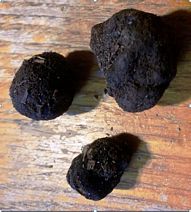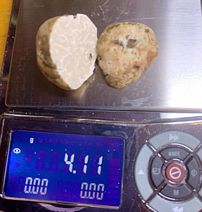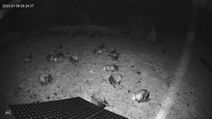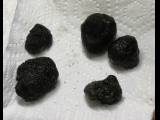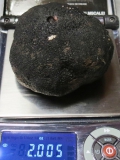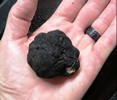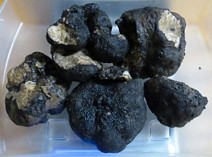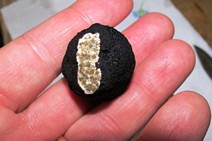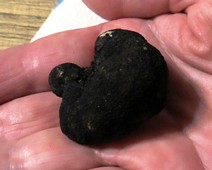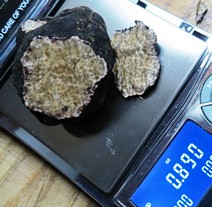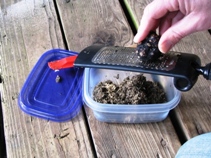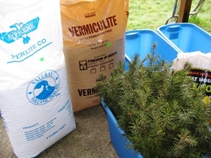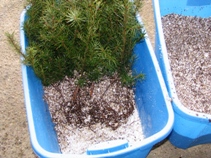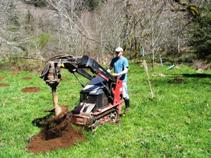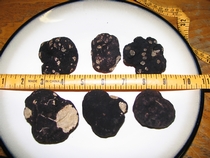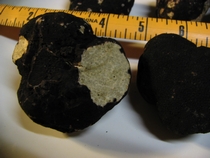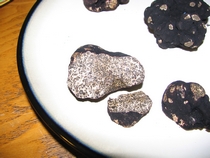

| Oregon TruffleTryst Truffière Oregon TruffleTryst Truffière | 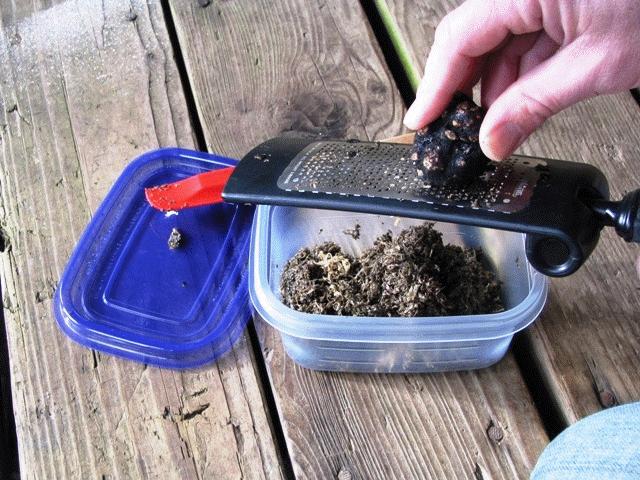 |
Truffles have again been very limited so far this winter. I did find a couple last spring into May, a couple at the end of this past November and a couple in December including a white truffle in the same patch. I still believe it was a mistake to leave the fence down around the truffle trees. There has been a lot more elk traffic through them this past year and I noticed quite a number of surface scrapes after they had been through. I am uncertain if this is just them marking areas, or whether they are trying to roll out truffles under the loose duff. Still, I've found far fewer truffles, and far fewer holes from critters digging up truffles, since the fence has been down. Until I can get around to buying some new fencing and getting the patch enclosed again, I won't know if the easy access afforded to the elk, deer, coyotes and mountain lions has any effect on the number of truffles.
Apr 2021 --
It has been a pretty dismal year for our truffle patch. Although I haven't looked very consistently this year, I didn't find a single truffle. Rodent activity seemed very limited with very few holes that might be considered truffle holes (dead end holes only an inch or two deep and a little less wide). I have noticed that colder spells in the winter seemed to coincide with increased truffles ... or at least an increased number of rodent holes and bits of truffles on the surface. This winter was again fairly mild with very few nights below freezing . On a side note, this also means more insects have survived the winter, so there will be lots more around this summer. Not a fan of the increased number of gnats, flies, ticks , etc. after a warm winter. I had a field fence around the truffle tree plot to protect the trees when they were much smaller. I've removed some of that on one end, a gate on the other, and some of the fence has been torn down over the past year. This allows the elk to meander through the trees, which they have done on a number of occasions through this winter. I don't know if their feet may damage some of the truffles, or disrupt their mycelium network. They also tend to scrape up the organic top layer that is mostly needles. I may replace that fence just to see if it seems to help.
Jan 2020 --
The number of holes showing up this fall were steadily increasing through November, but seems to have slowed toward the end of December. Half of the truffles found recently have been water-logged and old. We did find a few ripe black truffles on July 25th and August 17th, pretty much in the middle of summer! This fall we have also found a couple white truffles in the same patch as the black truffles.
Our daughter's little dog has been staying with us. Although he has had no training, he has begun to find a few truffles. We started by just walking him through the trees. Any time he stopped to smell a hole, if we thought it was where a truffle was dug out, we complimented him. At first we found the truffles, let him smell them, them complimented him and gave him a treat. Now he searches for them ... mostly ... as he is rather spastic most of the time :-). He has found about a dozen so far although almost all have been exposed to some extent on the surface. He has managed to find two or three that were completely covered but shallow. Most of the surface truffles he has found have been past their prime. One large one was immature, and of course, will never mature once removed. Still, it's promising.
May 2019 --
We still haven't found any truffles in the trees that were innoculated and planted in the front field. The small stand that is producing seemed to give up about the same amount this year (mostly guessing by the number of holes dug by forest critters and the number of 'leftovers' that we managed to rescue for ourselves).
May 2018 --
We managed to have a truffle dog out here late in the season. She did manage to find a small handful of ripe truffles! Unfortunately none of the truffles were found in the trees that were innoculated and planted in the front field.
Feb 2018 --
We have had some Black Truffles again this year although it appears that there were fewer truffles produced. I'm uncertain if they need very cold weather to produce their fruiting bodies, but our winter had been very mild up to a couple weeks ago when we got a few freezing nights. Once again I haven't found anyone with a truffle dog nearby to see how many truffles might actually be maturing. This year, but only starting in January, I placed a metal wire flag in each hole where varmits had dug up a truffle (by the smell or bits of truffle left behind) along with any hole larger than an inch in diameter that dead ended at a Fir tree root (likely held a truffle, but not necessarily). The trail cams and video cameras placed in the truffle trees show mice, squirrels, chipmunks, rabbits, possums, racoons, bobcat, coyotes and especially birds frequenting the area and digging in the duff. I have a number of mouse traps placed to try to keep the mouse-type population in check. Surprisingly the birds churn up the ground much, much more than any of the other critters.
May 2017 --
As mentioned by a wild truffle collector though an acquaintance, Oregon Black Truffles can continue to mature into late spring. We (and the truffle thieving critters) have still turned up fresh Oregon Black Truffles into the middle of May.
January 2017 --
We finally had some success finding Oregon truffles on the property. A few Oregon White truffles were found in an unanticipated area near the barn, occurring naturally. Several Oregon Black truffles were found around older trees than those planted and "innoculated" in 2008. Still, the trees where the truffles were found were "innoculated" by pouring a Black Truffle slurry around the base of the trees at the same time as the 2008 plantings. But the small number of trees and large number of 'critters' that like truffles will likely continue to make for slim pickings
 .
.
November 2014 --
Several of the Doug Fir trees in the main field have had large holes dug next to them, close to the trunks. By the size of the holes I would guess it something larger than mice or squirrels. I also did not notice any sign of insect nests around the trees before or after finding the holes. Bears have been documented digging for, or eating truffles, and we have regular visits by black bears. But I have not yet tested any of the trees to determine if any of them may have black truffle mycelium growing on their roots, or actual truffles.
September 2010 --
As part of my Horticulture studies, the trees in the main field were numbered, marked and measured for height and caliper. Three weed abatement treatments were randomly selected. They included recycled paper mats, moisture pourous plastic mats and using a propane torch to keep the weeds from growing around the trees. The final report, converted by Excel into a web page format can viewed HERE.
March 2008 --
Less than an acre of field has been set aside on the GCRF property for the attempt. Started in 2008, over 300 Douglas Fir seedlings have been innoculated with Oregon black truffles. Some of the black truffles were wild harvested and some were bought at the yearly Oregon Black Truffle Festival held in Eugene, Oregon. The Douglas Fir seedlings had their roots pressure washed and soaked in a disinfectant. They were placed in a slurry of Oregon black truffles for several days and then transferred to a mixture of peat, perlite, vermiculte and the remaining truffle slurry. After six to eight weeks they were transplanted to the field. Each of the original seedlings was covered with a plastic mesh tube to deter deer and elk browsing. Subsequent plantings without the plastic mesh protection suffered a loss of greater than 80% in the first year. Maybe the elk liked the truffle aroma
 .
.
Have a great day! bobf.
|
Please note: These soil maps are for a specific area around the GCRF. They have been password protected
due to a large number of visitors curious about the terrain around the site. You can view
the same maps at http://websoilsurvey.nrcs.usda.gov/app/. We are sorry
for any inconvenience this may cause you.
Have a great day! bobf. |
Terms of Service Privacy Policy
(with 579 cited references)
Find out about: America's (now the World's) Favorite Poison By Far!
... " just four companies — Bayer, Corteva (formerly DowDuPont), BASF and Syngenta/ChemChina — controlled 75 percent of plant breeding research, 60 percent of the commercial seed market, and 76 percent of global agrichemical sales in 2019."[78]
Monsanto / Bayer's Roundup Triggers Over 40 Plant Diseases and Endangers Human and Animal Health. Protect yourself and those you care about!
http://www.i-sis.org.uk/argentinasRoundupHumanTragedy.php
http://www.NaturalNews.com/031138_Monsanto_Roundup.html
[78] ETC Group. (2019, April 06). New report: Putting the cartel before the horse…and farm, seeds, soil, peasants. https://www.etcgroup.org/content/new-report-putting-cartel-horse%E2%80%A6and-farm-seeds-soil-peasants
|
Just Say No To GMO by Michael Adams - Video
https://www.naturalnews.com/NoGMO.html Just Say No To GMO by Michael Adams - Music https://oregonTruffleTryst.com/_MEDIA/JustSayNoToGMO-192.mp3 Song Lyrics
|
